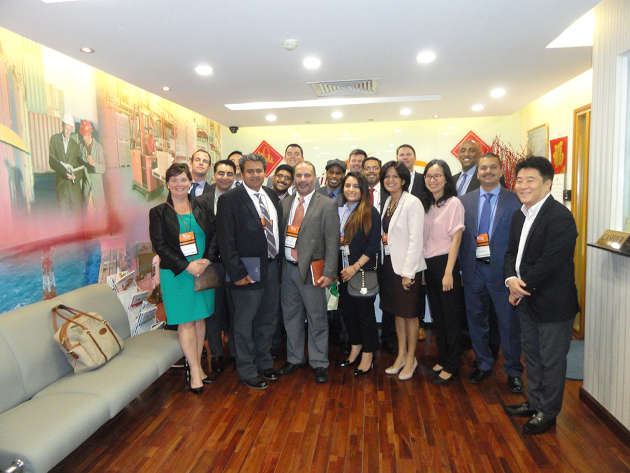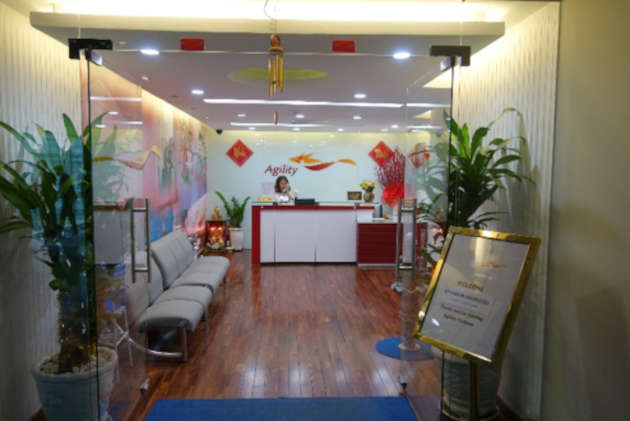
We kicked off our trip today with a visit to Agility Logistics, a worldwide leader in logistics services. As we got off the bus, we were greeted by Peter Lee and Ms. Thy. Lee is originally from South Korea and has functioned as commercial director at Agility Vietnam for the last seven years. Ms. Thy is the ocean director for all shipping logistics. Agility’s head office in Ho Chi Minh City is responsible for the Indochina region.
Rather than talking right away about the company’s day-to-day activities, we found it quite interesting that Lee started his presentation by giving us a historical overview of a war-torn Vietnam. He led us from the Nguyen Dynasty to the Indochina Wars, to the Vietnam Unification in 1975, and then Doi Moi.
Sitting through the overview left us wondering why there was so much history talk, and it dawned on us that it’s very important to know the country’s history in order to understand how Agility came to be. By knowing the past, it was easier to compare it with Vietnam’s current culture, specifically how rules and regulations have been established over the years. While Vietnam appears to be on track to climb the global Gross domestic product rankings, it still faces many challenges in terms of bureaucracy, lack of government planning, a war-torn past, unskilled labor and increasing wages. Peter gave us some very good insight on the current economic situation in Vietnam, which brought us to Agility’s current presence in Vietnam.

Agility started in Kuwait with roots in the oil-and-gas industry, as well as becoming the main logistics provider for the U.S. during war in Iraq. The company has a presence around the world, with 500 locations in 100 countries, giving it the ability to cater to international customers by offering a full-range of logistics services for many businesses, including Nike, Tuesday Morning, Brother, Shell, World Market and more. Additionally, the company is responsible for exporting crude oil from Vietnam to China.

From a strategic standpoint, Agility’s main strength is its ability to target emerging markets. However, some of the issues that it continues to face are infrastructure limitations, such as poor internet quality, government controls, resistance to the outside world, labor shortages and limited access to education.
Initially, we thought Agility was a small agency office that supported the company’s logistics operations, but that changed as Lee mentioned the office in Vietnam is key for the company’s growth in entering into 4PL (fourth-party logistics) — along with expecting more domestic road transports between neighboring countries. The office space was large enough to accommodate about 50 employees and had laptops on each desk. Everyone was doing his/her work with limited supervision.
Lee thought he could add more drivers and warehouse engineers to his existing staff faster than Agility’s administration is currently projecting. He believed more support to Vietnam’s education system is needed to provide the expertise required for his business.
We also had thought the decision by the United States to pull out of the Trans-Pacific Partnership would impact Vietnam’s trading and overall gross domestic product. However, we learned that Vietnam’s exports to the U.S. are up 21 percent and up over 36 percent between close Asian neighbors such as China, Japan, South Korea and Hong Kong. With many free trade agreements and strong ties with the European Union, Thy and Lee did not anticipate any major risks.
Nonetheless, it will be important for the Vietnamese government to negotiate with United States for trade partnership that will help Agility to be a large logistics player in the Asia-Pacific region. Agility is looking forward to competing with China in logistics. Thy was proud of the deep-water (55 feet) port Cai Mep toward the south end of Vietnam, which has easy access by road and close to major airports. She anticipated more international growth in logistics business and was looking to Cai Mep to help. Her concern was the warehouses around such ports and time taken to travel by road, which is currently 2,000 kilometers (1,242.74 miles) and takes about three and half days from north port to south port. She was very proud that Agility is doing more business with Cambodia, which takes trucking routes about six hours to deliver once the containers arrive in either Ho Chi Minh or Cai Mep port, and she expected substantial growth in that market as well.
In summary, Agility’s global network is spread across 500+ locations over 100 countries providing specialties services, supply chain management and freight forwarding. Agility’s primary export commodity volume in mobile and spare parts is $33 billion; garments is $22 billion;, and computers and accessories is $17 billion with high-tech industry companies such as Microsoft and Samsung in mobile, Nike in footwear, GE in energy, ABB in transformers and accessories, and many more.
Vietnam has a lot of growth potential in the logistics industry in the coming years, but to overcome challenges, it is very important for companies like Agility to make the government more aware of the business demands and needs that can help boost the economy and shape the future of this nation.
– Written by: Ajay Amberkar, Shawn Benjamin, Jesse Wang and Dustin West





